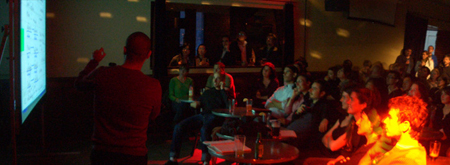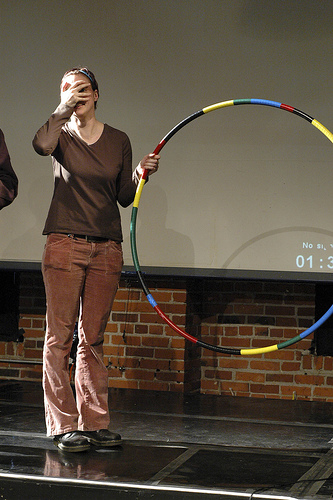Flash Presentations, 20/20
Here’s a great way to bring people up to speed, or connect people with new, unorthodox and unexpected ideas. Limit presentations to 20 slides, 20 seconds each. Six minutes total.
This flash presentation method really works. Instead of letting presenters drone on for 30-45 minutes with endless unreadable text-crammed slides, you set PowerPoint or Keynote to automatically display no more than 20 slides for no more than 15 to 20 seconds each. The result: 6-minute talks with dense, significant visuals, and everyone clamoring for more. It’s the blog version of a conference.
Try it where your work!
Very few ideas cannot be condensed to a 5-minute pitch. Very few can be done justice in 5 minutes either. But these flash demo sessions are not meant to exhaust a subject. Rather they are pitches meant to gather interest in face-to-face questions later. They work best in informal settings such as workshops, department staff meetings, or evening mixers at a cafe or gallery, where networking can happen afterwards.
Five-minute-pitch evenings have been a staple of the more innovative tech conferences for years, but usually as a side show. They are often run sort of like open mike nights. Anything could happen in those five minutes, including bad singing.
A few years ago some western design folks living in Japan formalized the format to just 20 slides for 20 seconds each. Each designer, architect, photographer or artist would get 6.5 minutes to showcase their work. The hosts would rent a bar for the evening and feature up to 20 designers in one evening. Afterwards every one would mingle and chat. Calling the event Pecha Kucha (chit chat in Japanese) the hosts scheduled one every month in Tokyo. Soon the concept was franchised around the world. You can find a Pecha Kucha in most design-crazy major cities.
I’ve attended several Pecha Kucha evenings in San Francisco, and they are pretty cool. Twenty slides, twenty seconds is more than plenty for most subjects and most presenters.

A group of geeks in London, inspired by Pecha Kucha, migrated the idea to technology and started Techa Kucha evenings. They later changed their name to Ask Later — as in listen for 6 minutes and ask questions later. About 8 years ago Douglas Repetto in NYC started Dorkbot as a scheduled tech demo night, offering peer support for folks “doing strange things with electricity.” Dorkbot is now a global grassroots network of geeks meeting regularly in 60 cities to demo their stuff informally.
Each dorkbot is different and is driven by the needs and interests of people in the local community. But generally, the main goals of dorkbot are: to create an informal, friendly environment in which people can talk about the work they’re doing and to foster discussion about that work; to help bring together people from different backgrounds who are interested in similar things; to give us all an opportunity to see the strange things our neighbors are doing with electricity. dorkbot isn’t really a forum for formal artist talks or lectures, but rather a chance for diverse people to have friendly conversations about interesting ideas.
While Dorkbot may have “lightening” demos, most of their presentations are 20-30 minutes. I’ve joined these longer session tech nights, and I find the additional constraints of the 20/20 flash format really helps refine the talks.
Brady Forrest, of O’Reilly Media, has further refined the tech hybrid version of flash presentations. He launched Ignite Seattle in which the geek demo evening of dorkbot is married to the formal limits of 20 slides. To further speed up the process, he limited the 20 slides to 15 seconds each, for a total of 5 minutes total for the entire demo, pitch, or show and tell. Previous Ignites sessions have included ways to hack chocolate, beekeeping ideas, or a paper airplane throwing contest (pictured below). All are available on video. If you are in the Seattle area there is a Ignite tonight.

Everywhere else, the format is waiting to be duplicated in your city. It works great as a mixer.
Also, a few businesses have discovered the virtues of the 20/20 format for internal meetings. I believe its a better alternative than simply banning PowerPoint presentations altogether, which some bold companies have done. I’d happily sit through 5-6 minutes of 20 slides rather than listen to 5-6 minutes of unfocused talk.
If your company tries this, I’d like to hear what happens.


